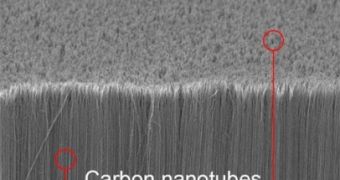Geckos have an odd ability that seems to allow them to defy gravity; it has been puzzling scientists (and superhero comics authors) for decades, as they hang upside-down on vertical surfaces with the least of efforts. By analyzing the Gecko feet, researchers were able to come up with a material that surpasses the results of the original.
US chemists led by Liming Dai from University of Dayton, Ohio and Georgia Institute of Technology's Zhong Lin Wang recently announced that they managed to create a material having ten times the adhesive properties of the Gecko foot. The thorough microscope study of the Gecko tissue responsible for the extraordinary feat was revealed to be formed of tiny hairs (setae) which are provided with even smaller branched tips (spatulae). This allows for a wide contact area between the animal's toes and any other surface, enhancing the effects of the van der Waals force (the faint attraction between neighboring molecules).
In order to mimic this effect, scientists have created microscopic spatulae out of an extremely dense forest-like structure of carbon nanotubes springing out of a silicon wafer. The nanotubes' tips were split and entangled like a sticky blanket. The material obtained this way was tested on various kinds of surfaces, from sandpaper to Teflon. For comparative and comprehensive purposes, it should be noted that 4mm2 (that a tiny square with a 2 mm side) of material stuck to a glassy surface can hold a weight of approximately 1.6 kilograms when pulled as parallel as possible to the respective surface. Just like the Gecko's foot, when pulled from a certain direction (directly perpendicular, in this case), the material loosens the grip to a minimum, so that a mere 160 grams would set the setae loose.
As Liming says, the applications that could use this kind of material range from the replacement of solder in electronics (since carbon nanotubes are such good conductors) to that of glues which dry too quickly in the outer space. When questioned about its viability for superhero suits, Liming answered, “We will exploit this possibility, if there is a serious need”. For now, the only drawback for a large scale application of the adhesive material is linked to its financial cost; although it has decreased more than 1.000 times since the nanotubes were discovered, due to new fabrication technology enhancements, it is still high.

 14 DAY TRIAL //
14 DAY TRIAL //